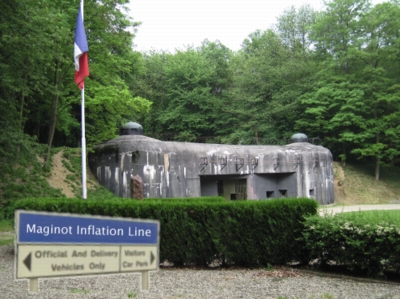 |
Central bank intervention and inflation: One thing leads to another
A popular misconception holds that central bank interventions in banking crises and financial markets panics in the form of liquidity injections are in and of themselves inflationary. Not so. These policies indicate a path decided, a choice in an economic policy fork in the road – a trap, if you will. We first identified the Federal Reserve's "inflationary decision making process" back in 1999.
Sadly it is neither difficult to discern nor complicated to explain. It is a well worn path taken by governments that have made a compounding series of policy errors. They are eventually backed into a corner, unable to finance expenses; lacking the will to reduce them, abandoned by allies due to economic or other troubles at home, the printing press its last defense of political obligations.
It starts when government determines in a recessionary environment, such as occurs after the collapse of an asset price bubble – as in tech stocks in 2000 or housing in 2007 – that high interest rates are politically unpalatable; they slow economic recovery and sharpen recessions in the short term. Recessions lead to rising unemployment, and unemployment mass produces unhappy voters. The printing comes under many names – reflation, deflation fighting, economic stimulus, or "emergency" actions taken without political cover of modern economic theory du jour.
Rather than allow markets to set interest rates at a natural higher equilibrium level among the factors of supply and demand for debt and inflation and default risk, the bank intervenes with liquidity – a fancy name for cash – to keep rates low. If the central bank does more than its trade partners on its own the result is both low interest rates and a weakened currency, as we have seen in the US since 2001 despite efforts by US trade partners to limit the dollar's fall with purchases of dollar denominated financial assets, mostly treasury bonds but, disastrously, also asset backed securities and Fannie Mae and Freddie Mac agency debt, which left the US five years later in the unfortunate position of needing to buy the discounted securities back with fully valued treasury bonds.
The weak dollar policy has never been acknowledged but the result is often pointed to by politicians and politically motivated economists as providing a fortunate boost in the US export sector, and lauded by the Treasury and Fed as effective economic stewardship. The inflation that inevitably resulted, especially in imported energy but all commodities, is the seed of a greater inflation that will follow, even as wages deflate in the recessionary economy.
Unconventional Policy
The extraordinary and unconventional policy responses of the US central bank were widely broadcast in policy papers issued by the Fed in the early 2000s under the heading of "fighting deflation." Like the Maginot Line that ably defended France against a direct attack by Germany across the German or Italian border at the start of WWII but failed when Germany attacked from Belgium instead, the Fed's deflation defense leaves the US vulnerable to an inflation invasion arriving from foreign shores as higher import costs, and whipped up by a lack of palatable options to fund government as tax revenues and foreign borrowing decline.
Poor Zimbabwe did not owe the world trillions in its own currency and so did not hold its trade partners hostage to cooperate in "unconventional coordinated interventions" designed to keep a stricken and fatally flawed global financial system alive that every day seems to beg to be allowed to die in peace.
Zimbabwe's fate was sealed back in 2003 when it embarked on its own "unconventional" methods of fighting bank failures and economic collapse.
The road to Inflation
Make no mistake: the US is on the road to inflation, and has been from the time it determined in the early 1980s to extend American purchasing power by means of foreign borrowing and domestic asset price inflation. The political will needed to get off the inflation path previously arrived in the late 1970s in the person of Paul Volcker. He worked in the background for many years to build consensus among US allies for the drastic measures taken in the early 1980s to kill The Great Inflation before it developed into a hyper-inflation. Is there a new Volcker out there, working with leaders in Asia and Europe and across the US, building consensus for a global currency appreciation, to get off the short term politically expedient of depreciation in order to avoid the long, difficult task of trade and monetary realignment?
The market action this past week votes: no. Stocks are pricing in continued leaderless, ad hoc responses by national governments, currency blocks, and trade blocks, although the G7 today issued a statement that major industrialized countries planned to do something or other together, drastic and soon, but not certain exactly what. A global financial system predicated on free capital flows and winner-take-all as the Asians learned during the 1997-98 currency crisis turns out to not lend itself to a process of geo-political reconciliation and shared economic sacrifice in a crisis. I can hear the Asian leaders say, "You want us to contribute to a global bailout pool now that you are in trouble? Remember the tens of billions your currency speculators pulled out of our economies ten years ago, throwing our economies into sudden recessions, while we kept our capital markets open at your insistence? We do. Count that as our share to your pool today."
As local and federal property and income tax revenues collapse in the US along with property prices and incomes, the Federal government will come under increasing pressure to print to fund all manner of "fixed" expenses – fixed in the sense that no politician wants to give up foreign or domestic spending commitments, from military outlays to health care entitlements to pension fund guarantees.
The blundering is by no means confined to the US. In Germany, where the ratio of public debt to GDP is even higher, older citizens who are keenly aware of the historical results of bad leadership in times of economic crisis
The statement below of Dr. G Gono, Governor, Reserve Bank of Zimbabwe, 30 April, 2008 grimly testifies to the likelihood the US, like Zimbabwe, may soon relearn that the "discredited textbook dogmas" that the Zimbabwe central bank and now the US central bank abandoned were conventions for a reason: every divergence from them, while politically expedient in the short term, is always a long run economic disaster.
By matter of degree and speed, the process that causes a nation to lose purchasing power varies with scale, political organization, institutions of government and industry, relations with trade partners, history, and culture – the full composite of the political economy. But one lesson always holds true: a leader, as JK Galbraith once said, is one who confronts directly the fundamental anxiety of his nation in his time. Ours have for more than 30 years avoided ours by means of papering them over with new forms of credit produced by increments – junk bonds, CDOs, and other products of financial engineering. As the mirage of extended purchasing power through finance dissolves into the night, they leave behind liabilities and expectations to be met by the same leaders but with the remaining machinery of low finance, the old fashioned type, the one that simply prints money. - Eric Janszen
FIRST QUARTER MONETARY POLICY STATEMENT: A FOCUS ON FOOD, FOREIGN EXCHANGE GENERATION, PRODUCER VIABILITY AND INCREASED SUPPLY OF BASIC COMMODITIES
BY DR G GONO, GOVERNOR, RESERVE BANK OF ZIMBABWE, 30 APRIL 2008
1. INTRODUCTION AND BACKGROUND
1.15 Banks, including those in the USA and the UK, are now not just talking of, but also actually implementing flexible and pragmatic central bank support programmes where these are deemed necessary in their National interests.
1.16 That is precisely the path that we began over 4 years ago in pursuit of our own national interest and we have not wavered on that critical path despite the untold misunderstanding, vilification and demonization we have endured from across the political divide.
1.17 Yet there are telling examples of the path we have taken from key economies around the world. For instance, when the USA economy was recently confronted by the devastating effects of Hurricanes Katrina and Rita, as well as the Iraq war, their Central Bank stepped in and injected life-boat schemes in the form of billions of dollars that were printed and pumped into the American economy.
1.18 A few months ago, the USA economy confronted a severe mortgage crisis, which threatened to spark an economy-wide recession.
1.19 The USA Central Bank again responded by injecting over US$160 billion between December, 2007 and March, 2008, to provide impetus to the American economy and prevent a worse crisis from happening.
1.20 A look at the recent developments in the UK equally reveals how increasingly, leading central banks in the global economy are bailing out troubled economic sectors to achieve macroeconomic and financial stability.
1.21 Faced with a yawning threat of systemic bank failures on the back of the aftermaths of that country’s mortgage crisis, the Bank of England was directed by its Government to intervene by providing a £50 billion lifeline to the UK’s banking sector.
1.22 Here in Zimbabwe we had our near-bank failures a few years ago and we responded by providing the affected Banks with the Troubled Bank Fund (TBF) for which we were heavily criticized even by some multi-lateral institutions who today are silent when the Central Banks of UK and USA are going the same way and doing the same thing under very similar circumstances thereby continuing the unfortunate hypocrisy that what’s good for goose is not good for the gander.
1.23 Those who yesterday did not see the interconnection between sanctions and the politics of this country as they sought conventional and dogmatic textbook methods of moving this economy now have good cause to reflect on these examples of quasi-fiscal interventions by the central banks in the USA and the UK and review their dogmas in the interest of adopting more flexible and dynamic approaches informed by the exigencies of the economic situation on the ground.
1.24 Our economy is and has been in trouble for over ten years and our extraordinary interventions by whatever name have helped to keep the wheels of this economy moving.
1.25 Even though our efforts have been criticized and derided clearly for undisguised political reasons, we are proud that we had the courage to do something that made a positive difference when it would have been far too easy for us to appear reasonable by doing nothing and thereby make the situation worse.
1.26 As Monetary Authorities, we commend those of our peers, the world over, who have now seen the light on the need for the adoption of flexible and practical interventions and support to key sectors of the economy when faced with unusual circumstances.
1.27 Of course, in the short-term such interventions are without doubt inflationary but in the medium to long-term they trigger and propel economic growth and development that everyone craves for.
1.28 One such universal unforeseen contingency, which now needs our urgent attention and intervention through unconventional means and without resorting to discredited textbook dogmas, is the unfolding global food and energy crisis.
BY DR G GONO, GOVERNOR, RESERVE BANK OF ZIMBABWE, 30 APRIL 2008
1. INTRODUCTION AND BACKGROUND
1.15 Banks, including those in the USA and the UK, are now not just talking of, but also actually implementing flexible and pragmatic central bank support programmes where these are deemed necessary in their National interests.
1.16 That is precisely the path that we began over 4 years ago in pursuit of our own national interest and we have not wavered on that critical path despite the untold misunderstanding, vilification and demonization we have endured from across the political divide.
1.17 Yet there are telling examples of the path we have taken from key economies around the world. For instance, when the USA economy was recently confronted by the devastating effects of Hurricanes Katrina and Rita, as well as the Iraq war, their Central Bank stepped in and injected life-boat schemes in the form of billions of dollars that were printed and pumped into the American economy.
1.18 A few months ago, the USA economy confronted a severe mortgage crisis, which threatened to spark an economy-wide recession.
1.19 The USA Central Bank again responded by injecting over US$160 billion between December, 2007 and March, 2008, to provide impetus to the American economy and prevent a worse crisis from happening.
1.20 A look at the recent developments in the UK equally reveals how increasingly, leading central banks in the global economy are bailing out troubled economic sectors to achieve macroeconomic and financial stability.
1.21 Faced with a yawning threat of systemic bank failures on the back of the aftermaths of that country’s mortgage crisis, the Bank of England was directed by its Government to intervene by providing a £50 billion lifeline to the UK’s banking sector.
1.22 Here in Zimbabwe we had our near-bank failures a few years ago and we responded by providing the affected Banks with the Troubled Bank Fund (TBF) for which we were heavily criticized even by some multi-lateral institutions who today are silent when the Central Banks of UK and USA are going the same way and doing the same thing under very similar circumstances thereby continuing the unfortunate hypocrisy that what’s good for goose is not good for the gander.
1.23 Those who yesterday did not see the interconnection between sanctions and the politics of this country as they sought conventional and dogmatic textbook methods of moving this economy now have good cause to reflect on these examples of quasi-fiscal interventions by the central banks in the USA and the UK and review their dogmas in the interest of adopting more flexible and dynamic approaches informed by the exigencies of the economic situation on the ground.
1.24 Our economy is and has been in trouble for over ten years and our extraordinary interventions by whatever name have helped to keep the wheels of this economy moving.
1.25 Even though our efforts have been criticized and derided clearly for undisguised political reasons, we are proud that we had the courage to do something that made a positive difference when it would have been far too easy for us to appear reasonable by doing nothing and thereby make the situation worse.
1.26 As Monetary Authorities, we commend those of our peers, the world over, who have now seen the light on the need for the adoption of flexible and practical interventions and support to key sectors of the economy when faced with unusual circumstances.
1.27 Of course, in the short-term such interventions are without doubt inflationary but in the medium to long-term they trigger and propel economic growth and development that everyone craves for.
1.28 One such universal unforeseen contingency, which now needs our urgent attention and intervention through unconventional means and without resorting to discredited textbook dogmas, is the unfolding global food and energy crisis.
Of course, the USA is not analogous to a tiny African nation without the long traditions of economic development and organization that the US enjoys. But a few facts about the Zimbabwe hyperinflation run counter to common misconceptions, such as the relationship between inflation and employment in periods of high inflation. Also, as GDP declines during the US recession and the Federal government increases deficit spending to bail out the financial sector, stimulate the economy, and fund state and local governments to compensate for declining tax revenues, the ratio of national public debt to GDP is likely to explode over the next two years.
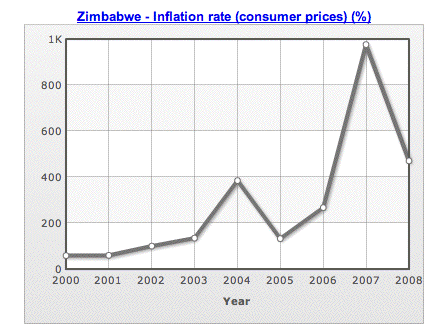
Inflation was manageable until 2001.
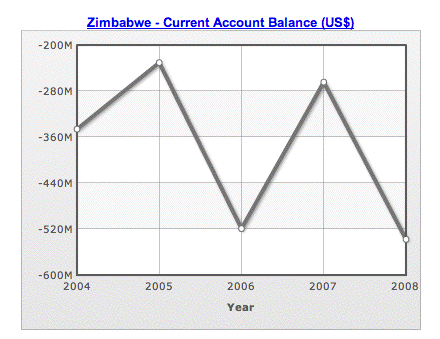
Current account balance spiked, declined, then spiked the year
before the hyperinflation started.
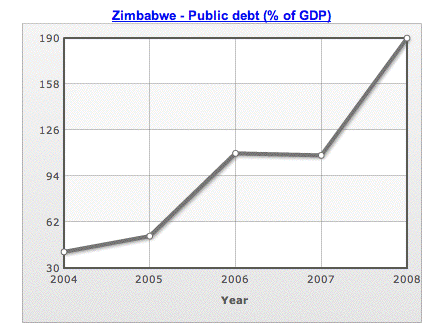
Total public debt was 115% of GDP the year before
the hyperinflation started. US public debt was 40% of GDP
in 2007. (Does not include $60 trillion in Medicare and
Social Security obligations.) Public debt has increased by
$500 billion per year since 2003. When GDP falls during recession
next year while spending increases to stimulate the economy,
we expect that ratio to rise to 60% of GDP by the
end of 2010.
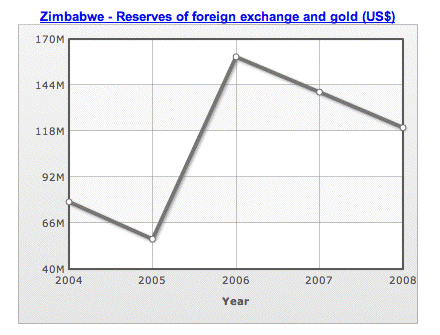
As issuer of the world's primary reserve currency, the US
ranks 23rd in currency reserves, behind Poland, Turkey,
Mexico, and Libya.
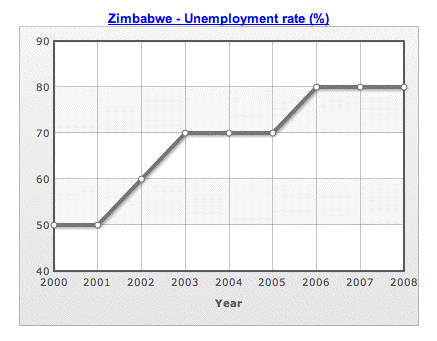
The Zimbabwe economy had been in serious trouble for
many years before the hyperinflation. Unemployment
rose from 50% to 80% after the hyperinflation started.
We hope these data help to dispel the persistent myth that
high unemployment necessarily leads to low inflation.
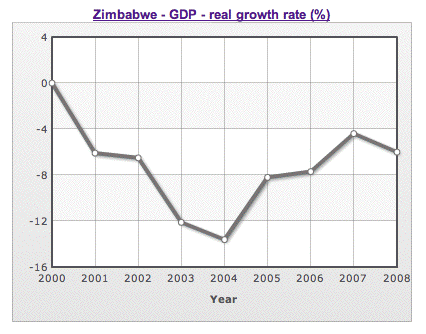
Real (inflation-adjusted) GDP growth fell in the years
before the hyperinflation.
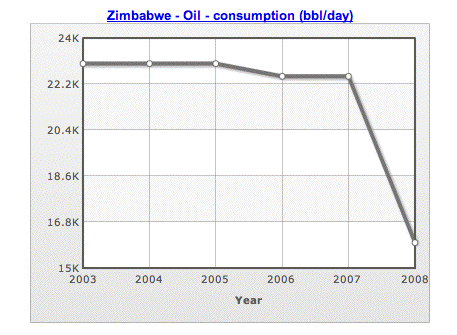
Oil demand remained high but consumption fell because
oil priced in Zimbabwe's currency became very expensive.
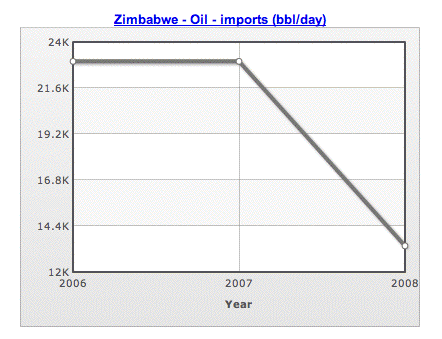
Oil imports fell.
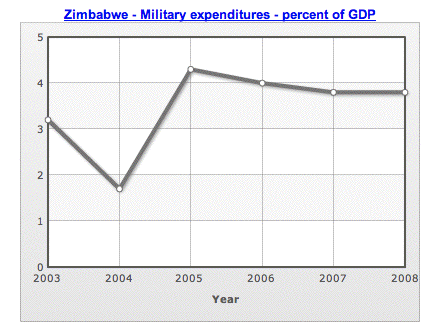
The main reason governments print money is to pay for "critical"
liabilities such as the military that foreign borrowing nor finance
nor taxes will fund.
Source: CIA World Factbook
iTulip Select: The Investment Thesis for the Next Cycle™
__________________________________________________
To receive the iTulip Newsletter or iTulip Alerts, Join our FREE Email Mailing List
Copyright © iTulip, Inc. 1998 - 2007 All Rights Reserved
All information provided "as is" for informational purposes only, not intended for trading purposes or advice. Nothing appearing on this website should be considered a recommendation to buy or to sell any security or related financial instrument. iTulip, Inc. is not liable for any informational errors, incompleteness, or delays, or for any actions taken in reliance on information contained herein. Full Disclaimer


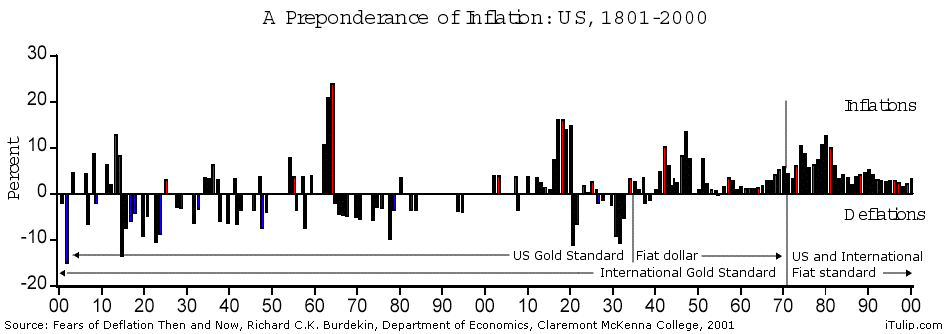
Comment